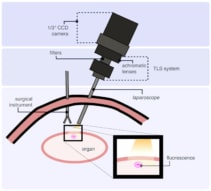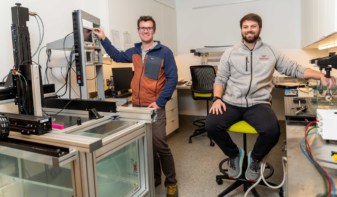
Davide Volpi and collaborators at the Oxford Institute for Radiation Oncology in the UK have developed an electrical lens system for fluorescence-guided laparoscopic surgery, a minimally invasive procedure that exploits fluorescent biomarkers to help clinicians remove cancerous or abnormal tissues from the abdomen.
Such minimally invasive techniques have become increasingly popular over last few years, since they reduce recovery time and the overall risk to the patient, and the addition of fluorescence imaging offers improved contrast to allow smaller lesions to be treated.
In many cases, however, surgeons must work with very small areas of fluorescence in the tissue. A laparoscope that can zoom into an area of interest would therefore help to clinicians to distinguish and investigate these smaller areas, which should lead to more successful surgeries.
Improving image quality without distorting light

Volpi and colleagues have developed a tunable lens systems (TLS), a device that exploits electronics to change focus during operation, that can be integrated into commercially available laparoscopes (Biomed. Opt. Express 8 3232). While common in consumer cameras, such adjustable focus control has not yet been incorporated into a clinically viable setup. Furthermore, the research team made their device suitable for fluorescence-guided surgeries, for which it is vital to keep the light free of distortion as it passes through the lens.
The optical performance of the Oxford team’s TLS offers two key advantages. First, its fast response time of less than 7.5 ms allows it to switch focus extremely quickly, potentially allowing a fully autofocus capability or the use of two or three preset focus points (see visualization below).
Second, the TLS has been specifically designed to prevent the light distortion caused by chromatic aberrations. This is important for fluorescence-guided surgeries, since the most effective biomarkers generate fluorescence in the near-infrared (NIR). Optical tests showed that the TLS offered achromatic performance in the visible and NIR, enabling simultaneous imaging of white-light reflectance and fluorescence from the biomarkers.
Volpi and collaborators show in their paper also tested the performance of the TLS on animal models, obtaining in vivo images of tumours in mice. Fluorescence images obtained with a laparoscope fitted with the TLS appear noticeably sharper than a similar system equipped with a visible-NIR lens, suggesting that the TLS offers a viable option for fluorescence-guided laparoscopy surgeries in the clinic.



